
low visibility
01.07 - 21.08.2022
super bien! (Berlin)
Predominant cultural and power relations function within the logic of wholeness, finity, and completeness, success and individuality. And so when something breaks, or cracks, or is perhaps unable to render a perfect, ‘mirror’ reflection, it is no longer able to serve its normative purpose.
But does the “imperfect” reflection not give us something valuable? Are these aberrations not centers of possibility? Images are echoes, in-visibility is altered visibility. Shelley neither romaticizes nor negates virtual life(s) in favor of material life, but introduces spaces which test the ‘break’ potential of virtual engagements, languages, structures, and bounds, in relation to material life. She seeks both clarity and blur in the spaces that we define, and through which we are defined. She asks, “If I have no image, what do I reflect? If I have no body, what is my skin?”
-Shelley Odradek, 2022
(full exhibition text below)

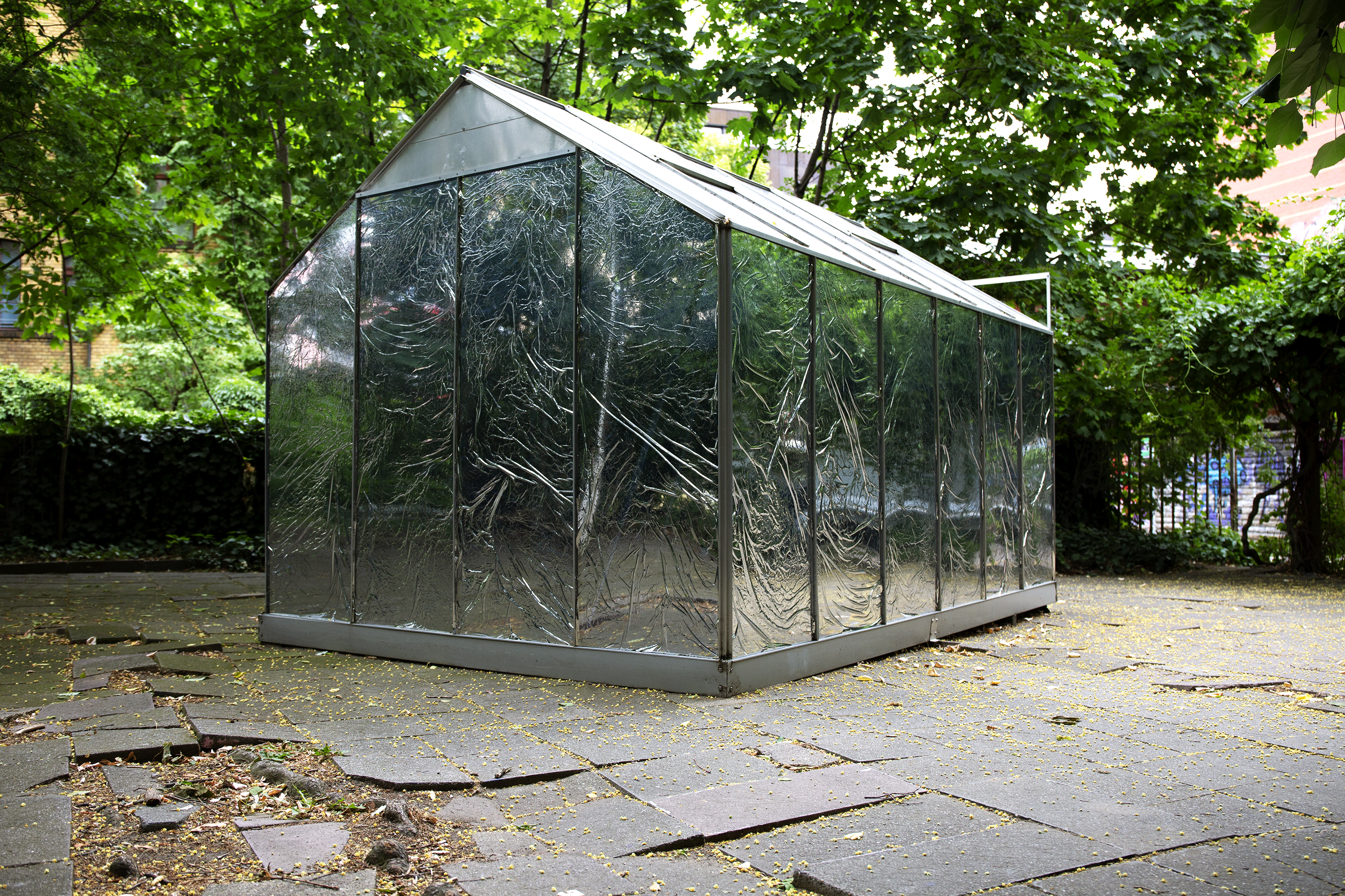
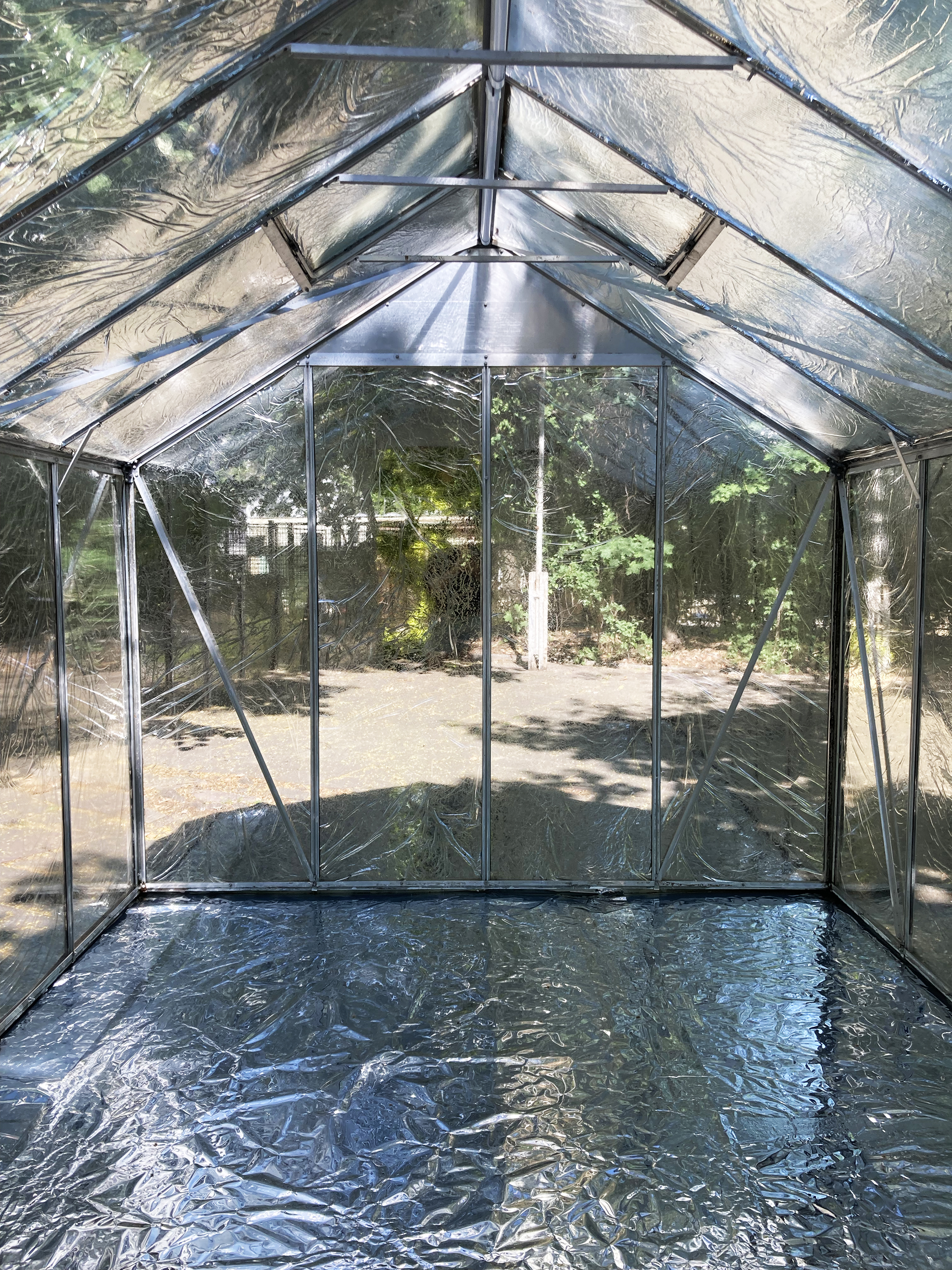
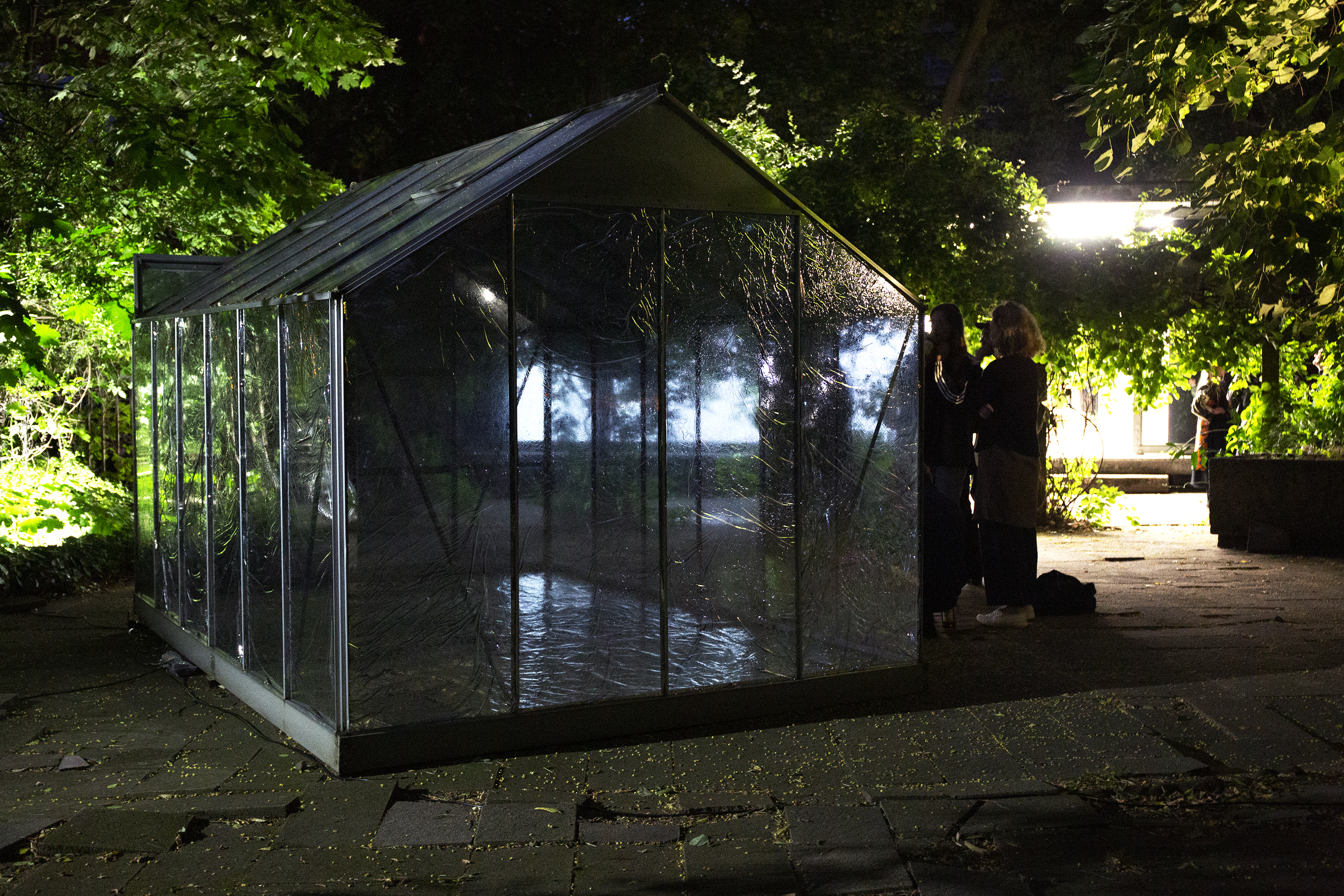
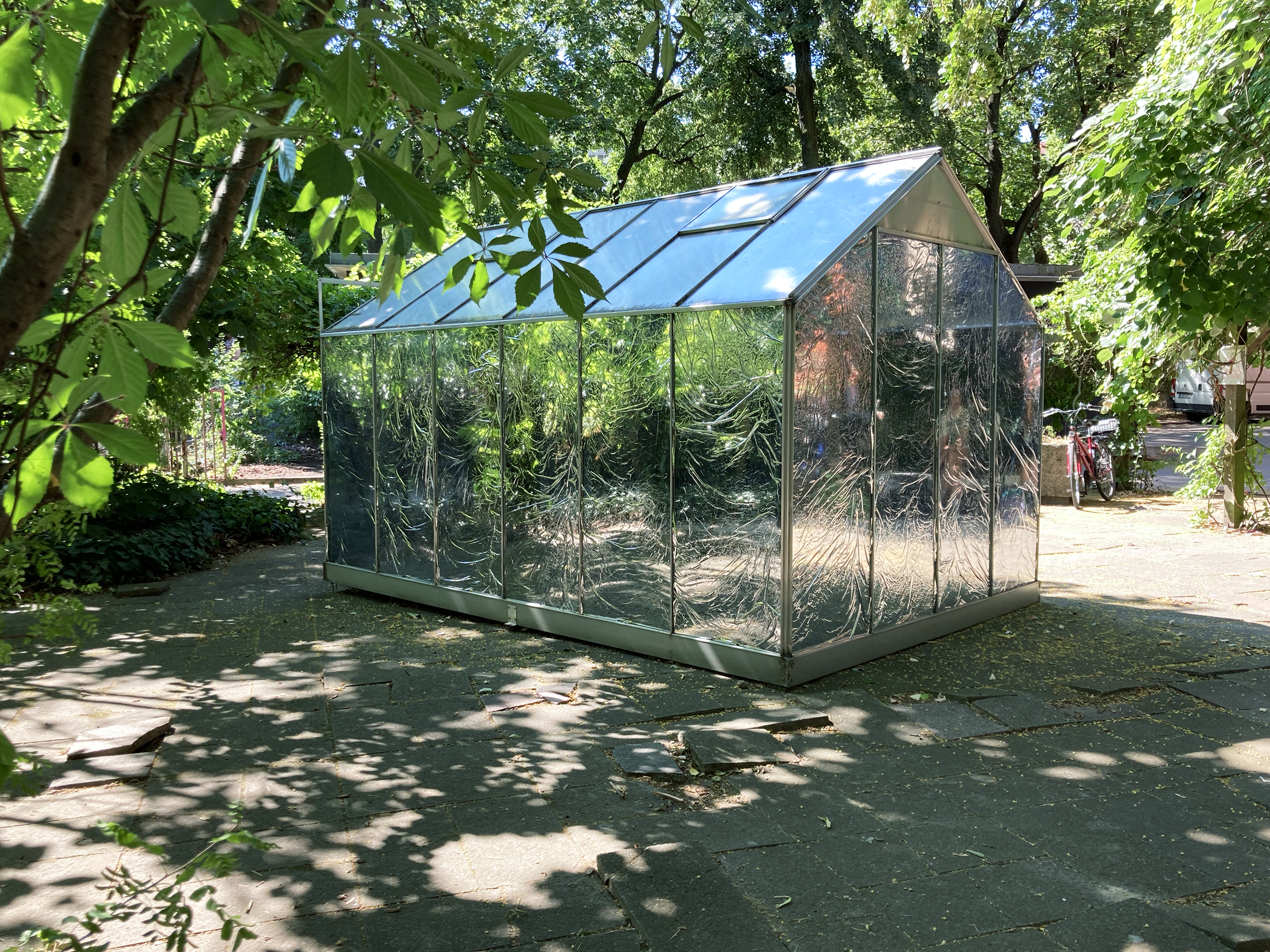
low visibility
A glasshouse is a space constructed of transparent material so as to provide a year-round regulated climate for plants. Intended to be an invisible structure, its transparency is intended to both encourage the flow of light and discourage the flow of energy. It is a skin. For low visibility, Shelley Odradek has covered the space of super bien! in mirror foil, shifting the transparency of the space, providing a site for distorted reflection; simultaneously reducing distinction between exterior + interior, and increasing the structural visibility.
Shelley neither romaticizes nor negates virtual life(s) in favor of material life, but introduces spaces which test the ‘break’ potential of virtual engagements, languages, structures, and bounds, in relation to material life. Like wrinkled, aging skin, the process of distortion becomes materialized. Blurring the spaces that we define, and through which we are defined, is the site of potential. Karen Barad asks “how matter comes to matter”, Shelley Odradek asks how failure/error/glitch becomes matter. She asks ”if I have no image, what do I reflect? If I have no body, what is my skin?”
Reflecting back a version of the surrounding environment, and the bodies that stand before it, the surface becomes a plane of contemplation: on distortion, on reflection, on truth of image, on mediation, on the material, on the digital. On reflection as a site of distortion. As an opportunity for new composition and folding and bending and echoing back a negotiated self, a self whose bounds are twisted like a mobius strip, at once interior_exterior, a construction that is not physical and digital, but rather physical + digital, neither one able to be complete without the other. As Edward Soja puts it, “Social reality is not just coincidentally spatial, existing ‘in’ space, it is presuppositionally and ontologically spatial. There is no unspatialized social reality, There are no aspatial social processes.” The spatial relation (read: echo chamber) of social-identity requires distorted materiality.
However, the predominant cultural and power relations function within the logic of wholeness, finity, completeness, serving capitalistic rules of perfection (≠distortion), clarity, and defined edges. And so when something breaks, or cracks – becomes “incomplete” – or is perhaps unable to render a “perfect” reflection, it is no longer able to serve its normative purpose. Philosopher Ewa Majewska writes about weak resistance and the politics of failure as sites for parody and exaggeration. Is the folding/creasing/sliding/wrinkling the gesture of a trickster, wielding the capacity to transcend patriarchal “strength” and its inherent symbolic violence? Who hasn’t stood in front of a fun house mirror or played around with the smartphone filters that distort and reframe our reflections, with equal parts hilarity and horror, as we acknowledge the instability of our subjective and objective relations?
Images are echoes, in-visibility is altered visibility. What was the poor image (Hito Steyerl) in the early 2000s is now nostalgic and filled with repositioned potential. The replicant distortions symbolize a materiality that has been rendered obsolete and inadequate in contrast to their new, sharp, high resolution, clear, contemporary counterparts, and demonstrate the need for collateral, rhizomatic representation. As Rebecca Solnit writes, the break relates to infinity and openness, expanding the potential of a closed circuit. Not so dissimilar from our dear friend Lia La Novia Sirena Garcia, who tenderly collects chipped and cracked ceramic and stoneware: physical metaphors for the “wrong”, “errored”, “non-normative” bodies resisting invisibility and marginalization.
The break here is in expectation, in the opaque border between image and projection, body and reflection.
![]()
download the text as a pdf here
A glasshouse is a space constructed of transparent material so as to provide a year-round regulated climate for plants. Intended to be an invisible structure, its transparency is intended to both encourage the flow of light and discourage the flow of energy. It is a skin. For low visibility, Shelley Odradek has covered the space of super bien! in mirror foil, shifting the transparency of the space, providing a site for distorted reflection; simultaneously reducing distinction between exterior + interior, and increasing the structural visibility.
Shelley neither romaticizes nor negates virtual life(s) in favor of material life, but introduces spaces which test the ‘break’ potential of virtual engagements, languages, structures, and bounds, in relation to material life. Like wrinkled, aging skin, the process of distortion becomes materialized. Blurring the spaces that we define, and through which we are defined, is the site of potential. Karen Barad asks “how matter comes to matter”, Shelley Odradek asks how failure/error/glitch becomes matter. She asks ”if I have no image, what do I reflect? If I have no body, what is my skin?”
Reflecting back a version of the surrounding environment, and the bodies that stand before it, the surface becomes a plane of contemplation: on distortion, on reflection, on truth of image, on mediation, on the material, on the digital. On reflection as a site of distortion. As an opportunity for new composition and folding and bending and echoing back a negotiated self, a self whose bounds are twisted like a mobius strip, at once interior_exterior, a construction that is not physical and digital, but rather physical + digital, neither one able to be complete without the other. As Edward Soja puts it, “Social reality is not just coincidentally spatial, existing ‘in’ space, it is presuppositionally and ontologically spatial. There is no unspatialized social reality, There are no aspatial social processes.” The spatial relation (read: echo chamber) of social-identity requires distorted materiality.
However, the predominant cultural and power relations function within the logic of wholeness, finity, completeness, serving capitalistic rules of perfection (≠distortion), clarity, and defined edges. And so when something breaks, or cracks – becomes “incomplete” – or is perhaps unable to render a “perfect” reflection, it is no longer able to serve its normative purpose. Philosopher Ewa Majewska writes about weak resistance and the politics of failure as sites for parody and exaggeration. Is the folding/creasing/sliding/wrinkling the gesture of a trickster, wielding the capacity to transcend patriarchal “strength” and its inherent symbolic violence? Who hasn’t stood in front of a fun house mirror or played around with the smartphone filters that distort and reframe our reflections, with equal parts hilarity and horror, as we acknowledge the instability of our subjective and objective relations?
Images are echoes, in-visibility is altered visibility. What was the poor image (Hito Steyerl) in the early 2000s is now nostalgic and filled with repositioned potential. The replicant distortions symbolize a materiality that has been rendered obsolete and inadequate in contrast to their new, sharp, high resolution, clear, contemporary counterparts, and demonstrate the need for collateral, rhizomatic representation. As Rebecca Solnit writes, the break relates to infinity and openness, expanding the potential of a closed circuit. Not so dissimilar from our dear friend Lia La Novia Sirena Garcia, who tenderly collects chipped and cracked ceramic and stoneware: physical metaphors for the “wrong”, “errored”, “non-normative” bodies resisting invisibility and marginalization.
The break here is in expectation, in the opaque border between image and projection, body and reflection.
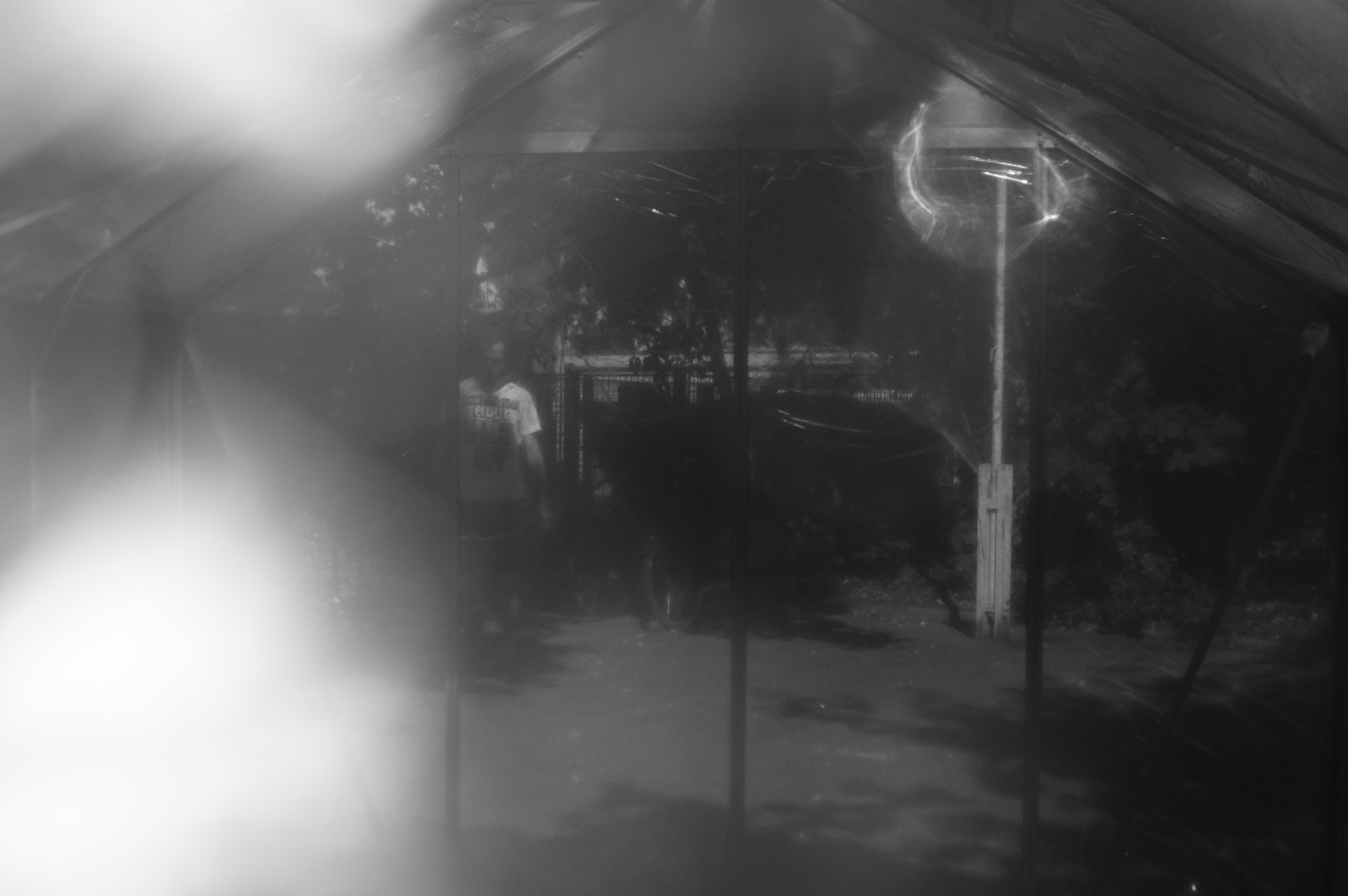
download the text as a pdf here